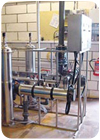
The novel “microsphere dosimeter” technique is the first direct test of how much UV light microorganisms in fluids have been exposed to, say the researchers - a critical step in validating the use of UV light treatment for preventing the spread of infection through drinking water. The technique uses fluorescent microspheres, which become bleached with exposure to UV light, to mimic pathogenic microbes in water flowing through a UV reactor. By measuring the bleaching of the microspheres, the researchers can obtain precise measures of the full distribution of UV doses that a pathogen may experience - information critical for gauging the treatment's capacity to kill disease-causing bacteria or parasites before they reach the public.
The new method comes at a key time as the Environmental Protection Agency (EPA) is set to introduce regulations in requiring water treatment plants at risk of infection to add UV reactors as an additional line of defense against pathogenic contaminants in the water supply.
The research was funded by the American Water Works Association Research Foundation. “The use of UV will certainly lower the public's risk of microbial pollution because it offers a second barrier of defense,” Karl Linden, an associate professor in Pratt's Department of Civil and Environmental Engineering, says. UV treatment will also reduce the need for chemical dis-infection, he adds.
In the United States, chemical treatment with chlorine remains the primary method for disinfecting drinking water, Linden notes. However, chlorine can produce chemical byproducts that have been linked to cancer. Such byproducts are also coming under stricter regulations in the new EPA rules for drinking water.
Chlorine also fails to kill some infectious microbes, such as the protozoan parasite Cryptosporidium, a common cause of waterborne disease in the U.S. In 1998, water quality researchers, including Linden, discovered that UV is very effective in killing Cryptosporidium, a finding that subsequently became a fundamental basis for the new EPA regulations. “While chlorine attacks the cell membrane, UV attacks organisms by breaking down their genetic material,” Linden explains. “Combining the two disinfection methods will better protect against known threats like Crypto and against the next 'bug of the month.'
“The microsphere dosimeter tool we've developed is an important step in advancing our understanding of how UV treatment works to disinfect drinking water,” he says. In addition to improvements in the fight against waterborne illness, UV also offers a more environmentally friendly water treatment method, Linden adds. Its implementation will allow a reduction in chlorine use, which will lower the concentration of chemical byproducts found in the water supply and help to meet the new byproduct standards.
The use of fluorescent microspheres to measure the UV dose distribution will augment earlier devised methods for characterizing UV systems, thereby raising confidence in the reactors' ability to combat health threats in the water supply, Linden says. Traditional methods simply test disinfection by spiking a water sample with bacteria or other surrogate microbes and measuring the number present after treatment to infer the delivered UV dose. However, that method provides only the average exposure when, in reality, microorganisms are exposed to a range of UV energy, depending upon the path they take in traveling through the UV system. “Many microbes display nonlinear responses to UV levels, which can make the average exposure a poor predictor for the actual efficacy of the reactor against different pathogens,” Linden asserts. “Microbes also differ in the level of UV required to successfully kill them.”
The new findings offer many fundamental and practical advances for UV reactor evaluation and testing. The tool also will help validate and improve the accuracy of mathematical models for estimating the efficiency of water treatment with UV.
Report Abusive Comment